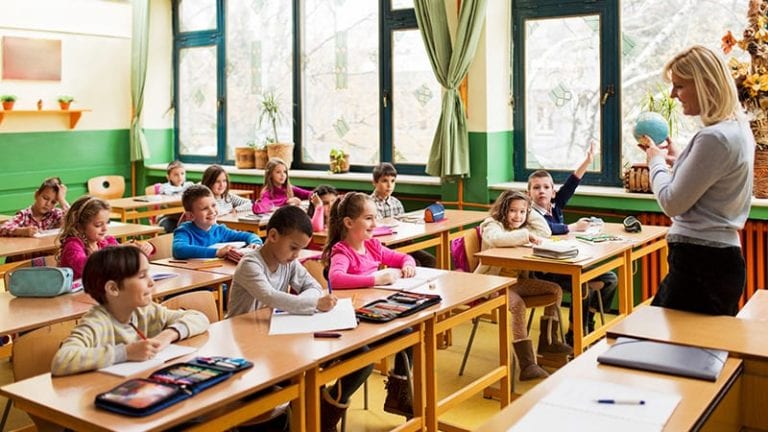“Hey, Mr. Z!? Some kids were calling you the G word. But don’t worry, I told them it wasn’t true,” exclaimed an eager second grade student in Mr. Zuidema’s classroom.
“Oh they were, were they?” Mr. Z replied. “Well you didn’t have to tell them that. I am gay!”
For Damon Zuidema, a former K–8 music educator, it was important for his students to know that he is gay and for his administration to be supportive of his decision to share so openly with his class. While Damon was met with a few disgruntled parents, it meant the world to him knowing that his administration had his back. “Knowing the complaints existed really hit me hard, but knowing that the administration supported me made it easier.”
Teachers who identify as LGBTQ have to navigate the reality that not all people will be supportive of them. And that impacts the classroom environment, and ultimately, a teacher’s ability to be a successful classroom educator. As school administrators, it is important to be aware of barriers that your LGBTQ teachers may be facing. In fact, a teacher’s comfort level and perceived safety in their school environment is directly linked to their students’ success in the classroom.
Your teachers have enough stress to deal with without having to wonder if they can be themselves in their classrooms. It is particularly important to consider the realities of LGBTQ teachers. A study conducted by GLSEN in 2007 and again in 2011 indicated that a significant number of LGBTQ teachers felt unsafe in their school environments. Additionally, one-third of those surveyed reported feeling that their jobs were at risk if they were out to students, staff, and administrators. Nearly 25 percent reported experiences of harassment in their school community because of their sexuality and/or gender identity.
When asked if he felt pressure to hide his sexuality to his students, Connor Schmidt, a primary school teacher in Beijing who is openly gay, shared:
“I was afraid they would mention it to their parents, and I would get in trouble with management.”
This fear—fear of coming out, fear of being true to one’s self, and fear of sharing with students—can have a negative impact on a teacher’s well-being. This, of course, will also affect student success. Though Connor did not share that he experienced direct hostility upon coming out to school leaders and students, he did speak openly about his fear that parents would respond negatively if he talked about his boyfriend with his students.
Jonny Vriesema, a physical education teacher in Jacksonville, Florida, who identifies as a gay Christian, fears that his desire to live out his faith and teach within religious schools will create conflict.
“There have definitely been positions that I did not apply for because I knew the administration would not support me.”
Having to navigate this reality has taken a toll, both personally and professionally, on Jonny. It’s common for LGBTQ educators, like Jonny, to encounter situations where they feel pushed out by administration. Unfortunately, in some communities, this act of being pushed out—or even outright fired—is perfectly legal.
In 28 states there is no comprehensive protection for LGBTQ educators against employment discrimination.
This glaring lack of legal support for LGBTQ teachers who face hostility creates a school environment that may be unsafe for teachers and students alike. If you work as an administrator in one of these states, encourage your district to adopt explicit employment protections for LGBTQ employees. If your district is not supportive, consider what you can do within your own school community for those teachers who may find themselves on the margins.
Jonny concluded by stating, “Being a member of the LGBTQ community is what makes me who I am. I also know that I want to be the best teacher out there. I want to show people that identify as a member of the LGBTQ community that they can do it, too.”
Get to know the needs of your community.
It is safe to assume that we all want the best for our students, staff, and administrators in our schools. With such an assumption, it is imperative to recognize that the needs of different communities in your schools are varied. What one teacher needs, another may not. Start with getting to know your community. Attempt to foster an environment where people do not feel the need to hide who they are and hold people accountable, yourself included, when they come up short.
Learn from a second grader’s response.
Damon’s response to his second grader’s surprise about him being gay was an easy one. “Yep. See that man in the picture on my desk? That is my boyfriend!”
“Oh, ok!” responded the student as he scurried away to the other side of the classroom. No more questions, no disdain, and no conclusion that Damon was any less of a teacher because of his sexuality. I think we can all learn from this second grader as we hope to lift up, value, and support all of the educators in our schools.
Join the great conversations going on about school leadership in our Facebook groups at Principal Life and High School Principal Life.
Plus check out this article about making your school environment safe for LGBTQ students.

